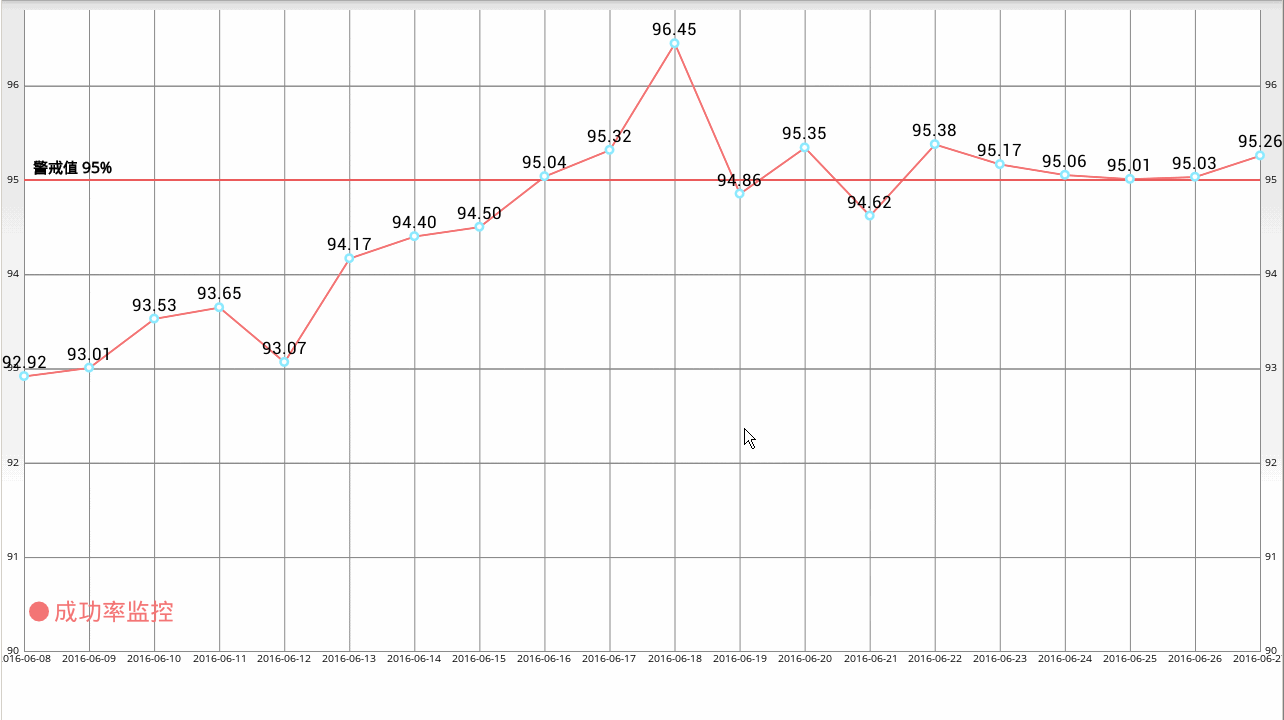最牛逼android上的图表库MpChart(二) 折线图
最近工作中,用到了mpchart图表库,现在分享受下mpchart图表库的各个图表在实际工作应用场景:
- 最牛逼android上的图表库MpChart(一) 介绍篇
- 最牛逼android上的图表库MpChart(二) 折线图
- 最牛逼android上的图表库MpChart(三) 条形图
- 最牛逼android上的图表库MpChart(四) 饼图
- 最牛逼android上的图表库MpChart(五) 泡泡图
使用mpchart jar包:mpandroidchartlibrary-2-1-6.jar
如果是在studio下,进行如下引用:
repositories {
maven { url “https://jitpack.io” }
}
dependencies {
compile ‘com.github.PhilJay:MPAndroidChart:v2.1.6’
}
MpChart折线图介绍
- LineChart类
使用哪些API
- setBackgroundColor(int color): Sets the background color that will cover the whole chart-view. In addition, a background-color can be set via .xml in the layout file.
- setDescription(String desc): Set a description text that appears in the bottom right corner of the chart.
- setDescriptionColor(int color): Sets the color of the description text.
- setDescriptionPosition(float x, float y): Sets a custom position for the description text in pixels on the screen.
- setDescriptionTypeface(Typeface t): Sets the Typeface used for drawing the description text.
- setDescriptionTextSize(float size): Sets the size of the description text in pixels, min 6f, max 16f.
- setNoDataTextDescription(String desc): Sets the text that should appear if the chart is empty.
- setDrawGridBackground(boolean enabled): If enabled, the background rectangle behind the chart drawing-area will be drawn.
- setGridBackgroundColor(int color): Sets the color the grid-background should be drawn with.
- setDrawBorders(boolean enabled): Enables / disables drawing the chart borders (lines surrounding the chart).
- setBorderColor(int color): Sets the color of the chart border lines.
- setBorderWidth(float width): Sets the width of the chart border lines in dp.
- setMaxVisibleValueCount(int count): Sets the number of maximum visible drawn value-labels - on the chart. This only takes affect when setDrawValues() is enabled.
MpChart折线图实例
- 布局文件
- Java代码
<RelativeLayout xmlns:android="http://schemas.android.com/apk/res/android"
xmlns:tools="http://schemas.android.com/tools"
android:layout_width="match_parent"
android:layout_height="match_parent" >
<com.github.mikephil.charting.charts.LineChart
android:id="@+id/chart1"
android:layout_width="match_parent"
android:layout_height="match_parent"/>
</RelativeLayout>package com.example.mpchart;
import java.util.ArrayList;
import android.app.Activity;
import android.graphics.Color;
import android.graphics.Typeface;
import android.os.Bundle;
import android.os.Handler;
import android.os.Looper;
import android.os.Message;
import android.view.WindowManager;
import com.example.mpchart.data.IDataSource;
import com.example.mpchart.data.IDataSource.onDataChangedListener;
import com.example.mpchart.data.SucRateDataSource;
import com.example.mpchart.utils.DBHelper;
import com.example.mpchart.utils.DateUtils;
import com.example.mpchart.utils.LogUtils;
import com.github.mikephil.charting.charts.LineChart;
import com.github.mikephil.charting.components.Legend;
import com.github.mikephil.charting.components.Legend.LegendDirection;
import com.github.mikephil.charting.components.Legend.LegendForm;
import com.github.mikephil.charting.components.LimitLine;
import com.github.mikephil.charting.components.LimitLine.LimitLabelPosition;
import com.github.mikephil.charting.components.XAxis;
import com.github.mikephil.charting.components.XAxis.XAxisPosition;
import com.github.mikephil.charting.components.YAxis;
import com.github.mikephil.charting.components.YAxis.YAxisLabelPosition;
import com.github.mikephil.charting.data.Entry;
import com.github.mikephil.charting.data.LineData;
import com.github.mikephil.charting.data.LineDataSet;
public class MainActivity extends Activity {
private static final String TAG = "MainActivity";
private LineChart mChart;
private IDataSource mDataSource = new SucRateDataSource();
private Handler mHandler = new Handler(Looper.getMainLooper()) {
@Override
public void handleMessage(Message msg) {
super.handleMessage(msg);
getData();
}
};
@Override
protected void onCreate(Bundle savedInstanceState) {
super.onCreate(savedInstanceState);
getWindow().setFlags(WindowManager.LayoutParams.FLAG_FULLSCREEN,
WindowManager.LayoutParams.FLAG_FULLSCREEN);
setContentView(R.layout.activity_main);
mChart = (LineChart) findViewById(R.id.chart1);
// //在chart上的右下角加描述
mChart.setDescription(mDataSource.getDescription());
mChart.setDescriptionTextSize(30);
// //设置Y轴上的单位
// mChart.setUnit("%");
//设置透明度
// mChart.setAlpha(0.8f);
//设置网格底下的那条线的颜色
// mChart.setBorderColor(Color.rgb(213, 216, 214));
// mChart.setBorderColor(Color.rgb(0, 0, 0));
// mChart.setBackgroundColor(Color.rgb(255, 255, 255));
mChart.setGridBackgroundColor(Color.rgb(255, 255, 255));
//设置Y轴前后倒置
// mChart.setInvertYAxisEnabled(false);
// //设置高亮显示
// mChart.setHighlightEnabled(true);
//设置是否可以触摸,如为false,则不能拖动,缩放等
mChart.setTouchEnabled(true);
//设置是否可以拖拽,缩放
mChart.setDragEnabled(true);
mChart.setScaleEnabled(true);
//设置是否能扩大扩小
mChart.setPinchZoom(true);
// 设置背景颜色
// mChart.setBackgroundColor(Color.GRAY);
//设置点击chart图对应的数据弹出标注
MyMarkerView mv = new MyMarkerView(this, R.layout.custom_marker_view);
// define an offset to change the original position of the marker
// (optional)
// mv.setOffsets(-mv.getMeasuredWidth() / 2, -mv.getMeasuredHeight());
// mv.setMinimumHeight(80);
// // set the marker to the chart
// mChart.setMarkerView(mv);
// // enable/disable highlight indicators (the lines that indicate the
// // highlighted Entry)
// mChart.setHighlightIndicatorEnabled(false);
//设置字体格式,如正楷
Typeface tf = Typeface.createFromAsset(getAssets(), "OpenSans-Regular.ttf");
mChart.setDescriptionTypeface(tf);
LimitLine ll1 = new LimitLine(95f, "警戒值 95%");
ll1.setLineWidth(2f);
// ll1.setLineColor(Color.rgb(0,0,0));
// ll1.enableDashedLine(10f, 10f, 0f);
ll1.setLabelPosition(LimitLabelPosition.LEFT_TOP);
ll1.setTextSize(15f);
ll1.setTypeface(tf);
XAxis xl = mChart.getXAxis();
// xl.setAvoidFirstLastClipping(true);
// xl.setAdjustXLabels(true);
xl.setPosition(XAxisPosition.BOTTOM); // 设置X轴的数据在底部显示
xl.setTypeface(tf); // 设置字体
xl.setTextSize(10f); // 设置字体大小
xl.setSpaceBetweenLabels(0); // 设置数据之间的间距'
YAxis yl = mChart.getAxisLeft();
yl.setPosition(YAxisLabelPosition.OUTSIDE_CHART);
// yl.setAxisMaxValue(220f);
yl.addLimitLine(ll1);
yl.setTypeface(tf); // 设置字体
yl.setTextSize(10f); // s设置字体大小
yl.setTypeface(tf);
yl.setAxisMinValue(90f);
yl.setStartAtZero(false);
// yl.setLabelCount(5); // 设置Y轴最多显示的数据个数
YAxis y2 = mChart.getAxisRight();
y2.setPosition(YAxisLabelPosition.OUTSIDE_CHART);
y2.setTypeface(tf); // 设置字体
y2.setTextSize(10f); // s设置字体大小
y2.setTypeface(tf);
y2.setAxisMinValue(90f);
y2.setStartAtZero(false);
getData();
new Thread(mRunnable).start();
}
private Runnable mRunnable = new Runnable() {
@Override
public void run() {
while(true) {
try {
Thread.sleep(15*1000);//每隔15s刷新一次,可以看到动态图
mHandler.sendMessage(mHandler.obtainMessage());
} catch (InterruptedException e) {
e.printStackTrace();
}
}
}
};
private onDataChangedListener listener = new onDataChangedListener() {
@Override
public void onChanged(String[] xx, String[] yy) {
notifyDataChanged(xx, yy);
}
};
private void getData() {
LogUtils.d(TAG, "getData() " + DateUtils.getCurrentDate());
new Thread(new Runnable() {
@Override
public void run() {
DBHelper.getInstance().init();
String sql = "select *from suc_rate_chart_0614";
final String[] xx = DBHelper.getInstance().query(sql,2);
final String[] yy = DBHelper.getInstance().query(sql,3);
mHandler.post(new Runnable() {
@Override
public void run() {
listener.onChanged(xx, yy);
}
});
}
}).start();
}
private void notifyDataChanged(String[] xx, String[] yy) {
Typeface tf = Typeface.createFromAsset(getAssets(),"OpenSans-Regular.ttf");
// 加载数据
setData(xx,yy );
//从X轴进入的动画
mChart.animateX(2000);
// mChart.animateY(2000); //从Y轴进入的动画
// mChart.animateXY(2000, 2000); //从XY轴一起进入的动画
//设置最小的缩放
mChart.setScaleMinima(0.5f, 1f);
//设置视口
// mChart.centerViewPort(10, 50);
// get the legend (only possible after setting data)
Legend l = mChart.getLegend();
l.setForm(LegendForm.CIRCLE); //设置图最下面显示的类型
l.setTypeface(tf);
l.setTextSize(30);
l.setTextColor(Color.rgb(244, 117, 117));
l.setDirection(LegendDirection.LEFT_TO_RIGHT);
l.setYOffset(100);
l.setFormSize(20f); // set the size of the legend forms/shapes
// 刷新图表
mChart.invalidate();
}
private void setData(String[] xx, String[] yy) {
ArrayList<String> xVals = new ArrayList<String>();
for (int i = 0; i < xx.length; i++) {
xVals.add(xx[i]);
}
ArrayList<Entry> yVals = new ArrayList<Entry>();
for (int i = 0; i < yy.length; i++) {
yVals.add(new Entry(Float.parseFloat(yy[i]), i));
LogUtils.d(TAG, "yVals() " + Float.parseFloat(yy[i]));
}
// create a dataset and give it a type
LineDataSet set1 = new LineDataSet(yVals, "成功率监控");
set1.setDrawCubic(false); //设置曲线为圆滑的线
set1.setCubicIntensity(0.2f);
set1.setDrawFilled(false); //设置包括的范围区域填充颜色
set1.setDrawCircles(true); //设置有圆点
set1.setLineWidth(2f); //设置线的宽度
set1.setCircleSize(5f); //设置小圆的大小
set1.setHighLightColor(Color.rgb(244, 117, 117));
set1.setColor(Color.rgb(244, 117, 117)); //设置曲线的颜色
// create a data object with the datasets
LineData data = new LineData(xVals, set1);
// set data
mChart.setData(data);
}
}























 2908
2908

 被折叠的 条评论
为什么被折叠?
被折叠的 条评论
为什么被折叠?








